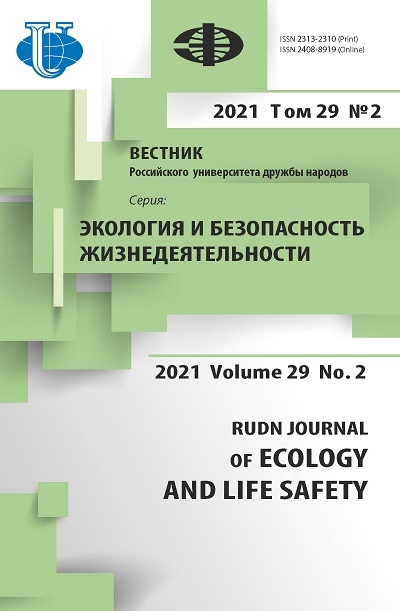State of Anemonoides altaica (C.A. Mey.) Holub cenopopulations in the south-east of the natural area
- Authors: Ilyina V.N.1
-
Affiliations:
- Samara State University of Social Sciences and Education
- Issue: Vol 29, No 2 (2021)
- Pages: 147-154
- Section: Ecology
- URL: https://journals.rudn.ru/ecology/article/view/30027
- DOI: https://doi.org/10.22363/2313-2310-2021-29-2-147-154
Cite item
Full Text
Abstract
Population ontogenetic studies are an important component of bioecological monitoring. The ontogenetic structure plays a role in determining the current state of natural populations, assessing the rarity status of a species in the region and throughout its range, and predicting the further development of the species. In the Samara region, natural cenopopulations of Anemonoides altaica (C.A. Mey.) Holub were studied on the territory of the Trans-Volga region (Sokol'ya mountains). According to the delta - omega criterion, most of them are mature, some are transitional and young. The revealed features of the ontogenetic structure and the calculated demographic indices of populations indicate the undoubted rarity and vulnerable position of the species in the region.
About the authors
Valentina N. Ilyina
Samara State University of Social Sciences and Education
Author for correspondence.
Email: 5iva@mail.ru
ORCID iD: 0000-0002-6692-2580
Candidate of Biological Sciences, Associate Professor, Associate Professor of the Department of Biology, Ecology and Teaching Methodology
26 Antonova-Ovseenko St, Samara, 443090, Russian FederationReferences
- Biybolatova ZA, Adzhiyeva AI. Ontogenetic structure of cenopopulations of the endemic Dagestan species Scabiosa gumbetica Boiss. Mezhdunarodnyy Zhurnal Prikladnykh i Fundamental'nykh Issledovaniy. 2014;(10–1):43–47. (In Russ.)
- Zhivotovskiy LA. Ontogenetic state, effective density and classification of populations. Russian Journal of Ecology. 2001;(1):3–7. (In Russ.)
- Zinenko MI, Yamskikh IYe. Variation and interrelation of traits of Anemonoides altaica growing in plant communities of the Western and Eastern Sayan Mountains. Byull. Botanical Garden-Institute FEB RAS. 2010;(5):55–57. (In Russ.)
- Vorontsova LI, Gattsuk LE, Egorova VN, Ermakova IM, Zhukova LA, Zaugolnova LB, Kurchenko EI, Matveev LE, Mikhailova TD, Prosvirnina EA, Smirnova OV, Toropova NA, Falikov LD, Shorina NI. Plant cenopopulations (basic concepts and structure). Moscow; 1976. (In Russ.)
- Kalliovirta M, Ryttäri T, Heikkinen RK. Population structure of a threatened plant, Pulsatilla patens in boreal forests: modelling relationships to overgrowth and site closure. Biodiversity Conservation. 2006;15:3095–3108.
- Muncaciu S, Gafta D, Cristea V, Roşca-Casian O, Irina G. Eco-coenotic conditions and structure of Trollius europaeus L. populations in an extrazonal habitat complex (Transylvanian Carpathian foothills). Flora. 2010;205(11):711–720. http://dx.doi.org/10.1016/j.flora.2010.04.017
- Saksonov SV, Vasyukov VM, Senator SA, Rakov NS, Sidyakina LV. About some relict elements of the flora of Middle Volga region. Samarskaya Luka: Problemy Regional'noy i Global'noy Ekologii. 2017;26(4):46–65. (In Russ.)
- Saksonov SV, Senator SA, Koneva NV. Classification of relict plants in the central part of the Volga Upland. Izv. Samar. SC RAS. 2011;13(5):64–67. (In Russ.)
- Mamushina NS, Zubkova YeK, Bubolo LS, Tyutereva YeV. Structural and functional characteristics of ephemeroids of the boreal zone. Botanical Journal. 2011;96(7):906–916. (In Russ.)
- Samosenko IYe, Shemberg MA. The state of cenopopulations of Anemone baikalensis (Ranunculaceae) in the Western Sayan. Botanical Journal. 1999;84(8):86–93. (In Russ.)
- Sharova M.A. Morphometric parameters of the spring ephemeroids Anemone altaica and Anemone ranunculoides in the natural and anthropogenic environment. Lomonosov Scientific Readings of Students, Postgraduates and Young Scientists of the Higher School of Natural Sciences and Technologies of NArFU – 2020. Arkhangelsk; 2020. p. 143–148. (In Russ.)
- Yakovlev IA, Abramova LM. Influence of anthropogenic load on the variability of biomorphological parameters of Anemonoides altaica (C.A. Mey.) Holub in ontogenesis. Influence of Physical, Chemical and Environmental Factors on the Growth and Development of Plants: Materials of the 4th All-Russian Scientific Conference at MGOPI. Moscow: MGOPI Publ.; 2007. p. 70–73. (In Russ.)
- Yamskikh IYe, Zinenko MI. Bioecological features of Anemonoides altaica in the southern part of the Krasnoyarsk territory. Problems of Botany of Southern Siberia and Mongolia: Materials of the VII International Scientific and Practical Conference. Barnaul; 2008. p. 104–106. (In Russ.)
- Yamskikh IYe, Kutsev MG, Uvarova OV. Polymorphism of Anemonoides altaica (S.A. Mey.) Holub populations in the mountains of Southern Siberia based on morphological data and ISSR-PCR analysis. Turczaninowia. 2011;14(1):10–18. (In Russ.)
- Yamskikh IYe, Chizhikova MI. The state of cenopopulations of Anemonoides altaica C.A. Mey. in the southern part of the Krasnoyarsk territory. Russian Journal of Ecology. 2011;(4):303–308. (In Russ.)
- Ilina VN. Some results of studies of cenopopulations of Anemone sylvestris L. (Ranunculaceae) in the Samara Trans-Volga region. Samarskaya Luka: Problems of Regional Global Ecology. 2009;18(4):159–170. (In Russ.)
- Yamskikh IYe, Kutsev MG. Polymorphism of Anemone baikalensis Turcz. populations. ex Ledeb. based on morphological data and RAF-PCR analysis. Turczaninowia. 2012;15(4):82–89. (In Russ.)
- Red Book of the Samara Region. Vol. I. Rare species of plants and fungi. 2nd ed., revis. and expan. Samara; 2017. (In Russ.)
- Golovlev AA. Anemonoides altaica (C.A. Mey.) Holub in the Sokol'i and Sorochinskii mountains. Ecology and Geography of Plants and Communities of the Middle Volga region. Tolyatti: IEVB RAN Publ.; 2014. p. 103–107. (In Russ.)
- Golovlev AA. New information on the distribution of the Altai anemic Anemonoides altaica (C.A. Mey.) Holub in Sokol'kie mountains. Natural Heritage of Russia: Collection of Scientific Articles of the International Scientific Conference, Dedicated to the 100th Anniversary of the National Nature Reserve and the Year of Ecology in Russia. Tolyatti: IEVB RAN Publ.; 2017. p. 271–272. (In Russ.)
- Glotov NV. On the assessment of the parameters of the age structure of plant populations. Life of Populations in a Heterogeneous Environment (part 1). Yoshkar-Ola: MarGU Publ.; 1998. p. 146–149. (In Russ.)
- Zhukova LA. Population life of meadow plants. Yoshkar-Ola: Lanar Publ.; 1995. (In Russ.)
- Rabotnov TA. Life cycle of perennial herbaceous plants in meadow cenoses. Tr. BIN AN SSSR. Ser. 3. Geobotanika. 1950;(6):7–204. (In Russ.)
- Uranov AA. Age spectrum of phytocenopopulation as a function of time and energy wave processes. Biologicheskiye Nauki. 1975;(2):7–34. (In Russ.)
















